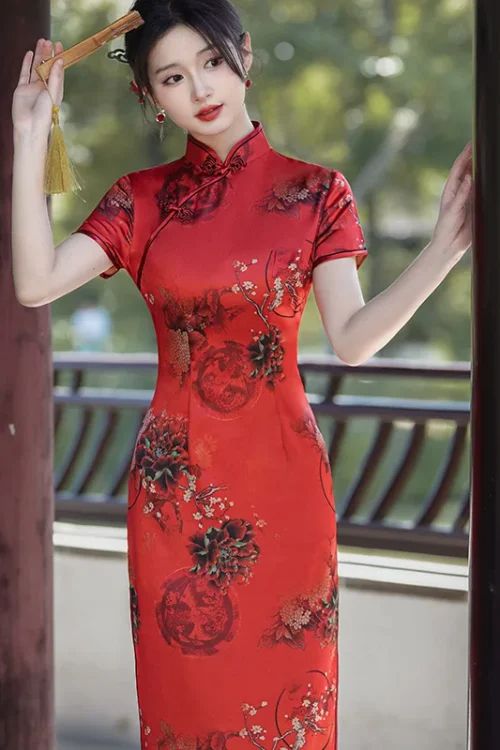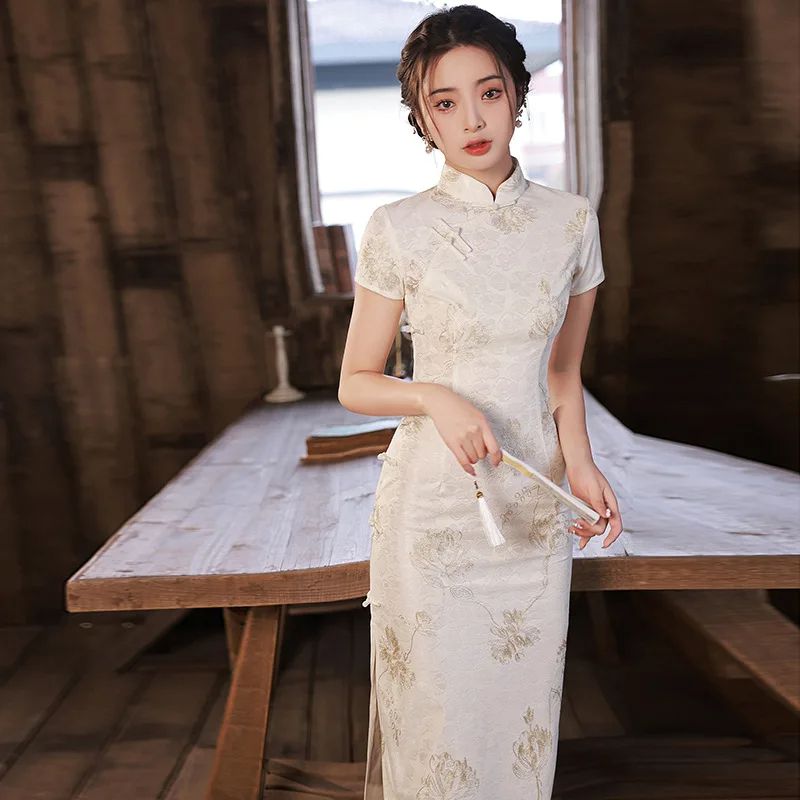The History and Evolution of Qipao Patterns
The qipao, an iconic Chinese dress, is renowned for its intricate and captivating patterns. These patterns have evolved over centuries, reflecting the cultural and artistic influences that have shaped Chinese society.

Early Patterns in the Qing Dynasty
The earliest qipao patterns emerged during the Qing dynasty (1644-1912). These patterns were often inspired by traditional Chinese motifs, such as dragons, phoenixes, and flowers. The patterns were typically embroidered in silk or satin, creating a luxurious and elegant effect.
Transformation During the Republican Era
During the Republican era (1912-1949), the qipao underwent a significant transformation. Western influences began to permeate Chinese fashion, and qipao patterns became more modern and streamlined. Geometric patterns, such as stripes and checks, became popular, as did floral and abstract designs.
Post-World War II Developments
In the post-World War II era, the qipao continued to evolve. Designers experimented with new materials and techniques, such as lace and beading. The patterns became more elaborate and sophisticated, reflecting the growing affluence and cosmopolitanism of Chinese society.
Contemporary Diversity
Today, qipao patterns are as diverse as ever. Traditional motifs continue to be popular, but designers are also incorporating contemporary elements, such as pop art and graffiti. The qipao has become a symbol of Chinese cultural heritage while also embracing the influences of the modern world.
Symbolic Meanings of Patterns
The patterns on qipao are not merely decorative; they also convey symbolic meanings. For example, the dragon pattern represents power and authority, while the phoenix pattern symbolizes beauty and grace. Floral patterns often represent fertility and prosperity, while geometric patterns can symbolize order and harmony.
Occasion-Based Choices
The choice of pattern on a qipao is often influenced by the occasion. For formal events such as weddings and banquets, qipaos with elaborate patterns are typically worn. For more casual occasions, qipaos with simpler patterns are more appropriate.
Versatility of the Qipao
The qipao is a versatile garment that can be dressed up or down, depending on the occasion. The patterns on qipao are an integral part of its appeal, reflecting the rich cultural heritage and artistic traditions of China.
Symbolism and Meaning Behind Qipao Patterns
The qipao, a traditional Chinese dress, is renowned for its intricate and symbolic patterns. Each motif carries a profound meaning, reflecting the wearer’s aspirations, beliefs, and cultural heritage.

Floral Patterns
Flowers are a ubiquitous motif in qipao patterns, representing beauty, prosperity, and good fortune. Peonies symbolize wealth and honor, while lotus flowers embody purity and enlightenment. Chrysanthemums signify longevity and joy, and plum blossoms herald the arrival of spring and new beginnings.
Animal Patterns
Animals also feature prominently in qipao designs. Dragons represent power, strength, and good luck. Phoenixes symbolize beauty, grace, and immortality. Butterflies embody transformation and freedom, while fish signify abundance and prosperity.
Geometric Patterns
Geometric patterns, such as clouds, waves, and mountains, evoke the natural world. Clouds represent good fortune and prosperity, while waves symbolize the flow of life and the ebb and flow of time. Mountains signify stability and strength.
Symbolic Colors
The colors used in qipao patterns also carry symbolic meanings. Red represents joy, prosperity, and good luck. Green symbolizes growth, harmony, and vitality. Blue represents peace, tranquility, and wisdom. Yellow signifies wealth, power, and nobility.
Cultural Significance
Qipao patterns are not merely decorative elements; they reflect the wearer’s cultural identity and social status. During the Qing dynasty, different patterns were reserved for specific occasions and social classes. For example, women of the imperial court wore qipaos with elaborate dragon and phoenix motifs, while commoners wore simpler patterns.
Modern Interpretations
In contemporary fashion, qipao patterns have evolved to reflect modern sensibilities. Designers incorporate traditional motifs into modern silhouettes, creating a fusion of tradition and innovation. Some designers use abstract interpretations of classic patterns, while others experiment with new colors and materials.
Conclusion
The patterns on qipaos are a testament to the rich symbolism and cultural heritage of Chinese tradition. Each motif carries a profound meaning, reflecting the wearer’s aspirations, beliefs, and social status. Whether worn for special occasions or as a symbol of cultural pride, qipaos continue to captivate with their intricate and meaningful designs.
Modern Interpretations and Variations of Qipao Patterns
The qipao, a traditional Chinese dress, is renowned for its intricate and captivating patterns. These patterns hold cultural significance and reflect the wearer’s style and personality.

Historical Origins
The qipao’s patterns have evolved over centuries, influenced by various dynasties and cultural exchanges. During the Qing dynasty, the qipao became a symbol of national identity, and its patterns often incorporated auspicious symbols such as dragons, phoenixes, and peonies.
Traditional Patterns
Traditional qipao patterns are typically symmetrical and feature motifs inspired by nature, such as flowers, birds, and landscapes. These patterns are often embroidered or printed in vibrant colors, creating a visually stunning effect.
Modern Interpretations
In recent years, qipao patterns have undergone a resurgence of popularity, with designers incorporating modern elements and reinterpreting traditional motifs. Geometric patterns, abstract designs, and even pop culture references have found their way onto qipao.
Variations in Patterns
The patterns on qipao vary depending on the region and the wearer’s personal preferences. For example, Shanghai-style qipao often feature bold and geometric patterns, while Beijing-style qipao tend to have more delicate and floral motifs.
Symbolic Meanings
Many qipao patterns carry symbolic meanings. For instance, the peony represents wealth and prosperity, while the lotus symbolizes purity and enlightenment. The choice of pattern can convey a message about the wearer’s aspirations or beliefs.
Cultural Significance
The patterns on qipao are not merely decorative elements; they hold cultural significance and reflect the wearer’s identity. By choosing a particular pattern, individuals can express their heritage, values, and personal style.
Contemporary Applications
The versatility of qipao patterns has led to their incorporation into various contemporary fashion items, such as dresses, skirts, and blouses. These patterns add a touch of elegance and cultural flair to modern wardrobes.
Conclusion
The patterns on qipao are a testament to the rich cultural heritage of China. They have evolved over time, reflecting both traditional values and modern sensibilities. Whether worn in its traditional form or incorporated into contemporary designs, the qipao’s patterns continue to captivate and inspire.
